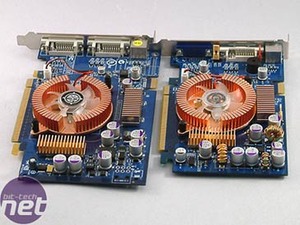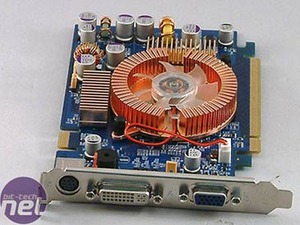
Since the release of NVIDIA's NV43 graphics processing unit last summer, we could say that NVIDIA have had the upper hand in the mainstream on both AGP and PCI-Express. It was almost the end of 2004 before ATI came out with a product that was able to compete with the GeForce 6600 GT in terms of price and performance.
The Radeon X700 Pro was not fast enough, and the Radeon X700 XT never existed due to problems with yield on the RV430 core. Along came the R430 core - the core that is underneath the heatsink on the Radeon X800 XL. There is also another product (or two, depending on which way you look at it) based on the R430. That product is known as the Radeon X800, and it comes in both 128MB and 256MB versions.
The 128MB version is priced very competitively with the GeForce 6600 GT, but it has problems with availability seeing as board partners seem more willing to push the 256MB version of the product. The additional memory means that the Radeon X800 256MB is priced around £30-40 more than the GeForce 6600 GT, meaning that it is debatable whether the GeForce 6600 GT really does have a competitor that doesn't suffer from availability.

 Today, we are looking at another GeForce 6600 GT from Galaxy. However, this one is a little different from the other GeForce 6600 GT's that we've evaluated, as it has a dual BIOS implemented on to the PCB. We'll come to this in due course, but that is not all that is different about this particular video card.
Today, we are looking at another GeForce 6600 GT from Galaxy. However, this one is a little different from the other GeForce 6600 GT's that we've evaluated, as it has a dual BIOS implemented on to the PCB. We'll come to this in due course, but that is not all that is different about this particular video card.
Looking at the Galaxy next to a BFG card, the cooling solutions are exactly the same, minus the sticker - copper with a blue LED fan. That's not all though, because the PCB has been dyed the same colour as BFGTech's too. However, aside from the obvious aesthetic similarities, you will note that Galaxy's GeForce 6600 GT Smart Flash is s smaller than a typical GeForce 6600 GT - it's thinner and shorter. This may, or may not make a difference and that will ultimately depend on how small your case is.
Users of conventional cases will not notice the difference, but if you are thinking of using a GeForce 6600 GT in a Home Theatre PC solution, you may find that this delivers fewer installation problems than a more conventional GeForce 6600 GT.

 Galaxy has opted to overclock their GeForce 6600 GT in much the same way as BFGTech have done, although they have chosen not to market this. The clock speeds are modest improvements over NVIDIA's reference clocks at 525/1050MHz, and to be honest, they make very little difference to best-playable settings in real world game play. That is not to say that this card should overclock a little further thanks to the increased factory clock speeds.
Galaxy has opted to overclock their GeForce 6600 GT in much the same way as BFGTech have done, although they have chosen not to market this. The clock speeds are modest improvements over NVIDIA's reference clocks at 525/1050MHz, and to be honest, they make very little difference to best-playable settings in real world game play. That is not to say that this card should overclock a little further thanks to the increased factory clock speeds.
The latest Forceware driver allows you to use differing VGA BIOS' in SLI mode, so this adds the scope for using two identically clocked video cards from different vendors. If you choose the Galaxy over a more conventionally sized GeForce 6600 GT, you will be limited to the same video card when you look to add a second card for SLI.
The backplate features DVI, VGA and TV-Out ports. There is scope for an additional DVI port, but Galaxy has chosen not to include one on this version of the card. The back plate configuration is usually region dependant, so you may well find that this card will have dual DVI ports in other regions.
The Radeon X700 Pro was not fast enough, and the Radeon X700 XT never existed due to problems with yield on the RV430 core. Along came the R430 core - the core that is underneath the heatsink on the Radeon X800 XL. There is also another product (or two, depending on which way you look at it) based on the R430. That product is known as the Radeon X800, and it comes in both 128MB and 256MB versions.
The 128MB version is priced very competitively with the GeForce 6600 GT, but it has problems with availability seeing as board partners seem more willing to push the 256MB version of the product. The additional memory means that the Radeon X800 256MB is priced around £30-40 more than the GeForce 6600 GT, meaning that it is debatable whether the GeForce 6600 GT really does have a competitor that doesn't suffer from availability.


Looking at the Galaxy next to a BFG card, the cooling solutions are exactly the same, minus the sticker - copper with a blue LED fan. That's not all though, because the PCB has been dyed the same colour as BFGTech's too. However, aside from the obvious aesthetic similarities, you will note that Galaxy's GeForce 6600 GT Smart Flash is s smaller than a typical GeForce 6600 GT - it's thinner and shorter. This may, or may not make a difference and that will ultimately depend on how small your case is.
Users of conventional cases will not notice the difference, but if you are thinking of using a GeForce 6600 GT in a Home Theatre PC solution, you may find that this delivers fewer installation problems than a more conventional GeForce 6600 GT.


The latest Forceware driver allows you to use differing VGA BIOS' in SLI mode, so this adds the scope for using two identically clocked video cards from different vendors. If you choose the Galaxy over a more conventionally sized GeForce 6600 GT, you will be limited to the same video card when you look to add a second card for SLI.
The backplate features DVI, VGA and TV-Out ports. There is scope for an additional DVI port, but Galaxy has chosen not to include one on this version of the card. The back plate configuration is usually region dependant, so you may well find that this card will have dual DVI ports in other regions.

MSI MPG Velox 100R Chassis Review
October 14 2021 | 15:04





Want to comment? Please log in.